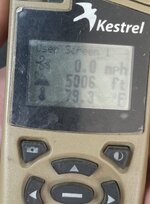- Joined
- Oct 22, 2014
- Messages
- 13,244
Roger. I see that it's one number not two like I use (temp and station pressure), but I don't understand how you're estimating pressure without a meter. I can guess temp and altitude pretty well, but not pressure. I can just stand by for your video; looking forward to it.
The bullet does not care where it’s actually at on the earth, only where is “feels” that it’s at- that means actual pressure. To generate that in a ballistics program, you generally put in altitude, BP, temperature, and humidity (leave at 50%) which converts all that “pressure”. Density altitude is pressure altitude corrected for a different temperature- I.E. where a bullet “feels” it’s at.
You need two things to get DA- temp and altitude in feet above sea level.
For instance
I guessed at 75° just based on how it felt today and 3,500ft ASL due to a rough guess based on my knowledge of the area. Below is the chart- find actually temp, go up the slanted lines until actual altitude, the go 90° left to read DA.
Doing that I read 5,100ft DA.
The actual was-
3,056ft and 79°
For a DA of 5,006 foot.

It takes my 6.5 cm and 130gr TMK 1,800 yards to change the data .1 mil between 5k DA and 5100ft DA.
